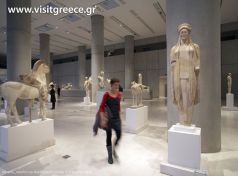Monuments and ancient sites
Greece is best known throughout the world as the cradle of democracy and the Olympic Games, and for its classical period (5th-4th century BC) which produced a flourishing of the intellect and glorious monuments such as the Parthenon. But that period accounts for only a fraction of the historical monuments and ancient sites which the visitor can marvel at in Greece today, spanning well over four millenia of civilization.
Perhaps no other country can in fact claim as extraordinary a diversity of monuments and ancient sites, due to the numerous states and empires that grew on or vied for control of this bridgehead between East and West. The monuments and sites of the classical period postdate by several centuries those of the palatial civilizations of Crete and Mycenae, and the settlement of Akrotiri on Santorini with the wonderful frescoes.
The list of ancient monuments and ancient sites includes the legendary and the renowned, such as the Acropolis of Athens, Knossos, Olympia, Delphi, Thera and Vergina (complemented by wonderful museums), as well as the obsure, such as those of the Kavirian deities on the islands of Lemnos and Samothrace, and the engineering feat of the Eupalinian tunnel on Samos. The ancient heritage includes a strong dose of Roman influence, as exemplified in the modified classical theaters, the Odeon of Herodus Atticus in Athens and the Galerian palatial complex of Thessaloniki.
The several regional empires and invaders who succeeded the Romans all made indelible additions to the list of monuments and ancient sites. The Byzantine era accounts for the countless number of churches and monasteries (notably the complexes of Mt. Athos and Meteora), as well as forts and ghost towns like Mystra. The Franks and Venetians left a strong architectural legacy, mainly in the form of awesome fortifications on the Peloponnese and the islands (Rhodes, Heraklion, Corfu, Nafplion, Methoni and Monemvassia most prominently). The Ottoman legacy is mainly evident in several mosques and institutions, such as Kavala’s Imaret, now a hotel. For a comprehensive guide to Greek museums, monuments and ancient sites, log on to http://odysseus.culture.gr.



